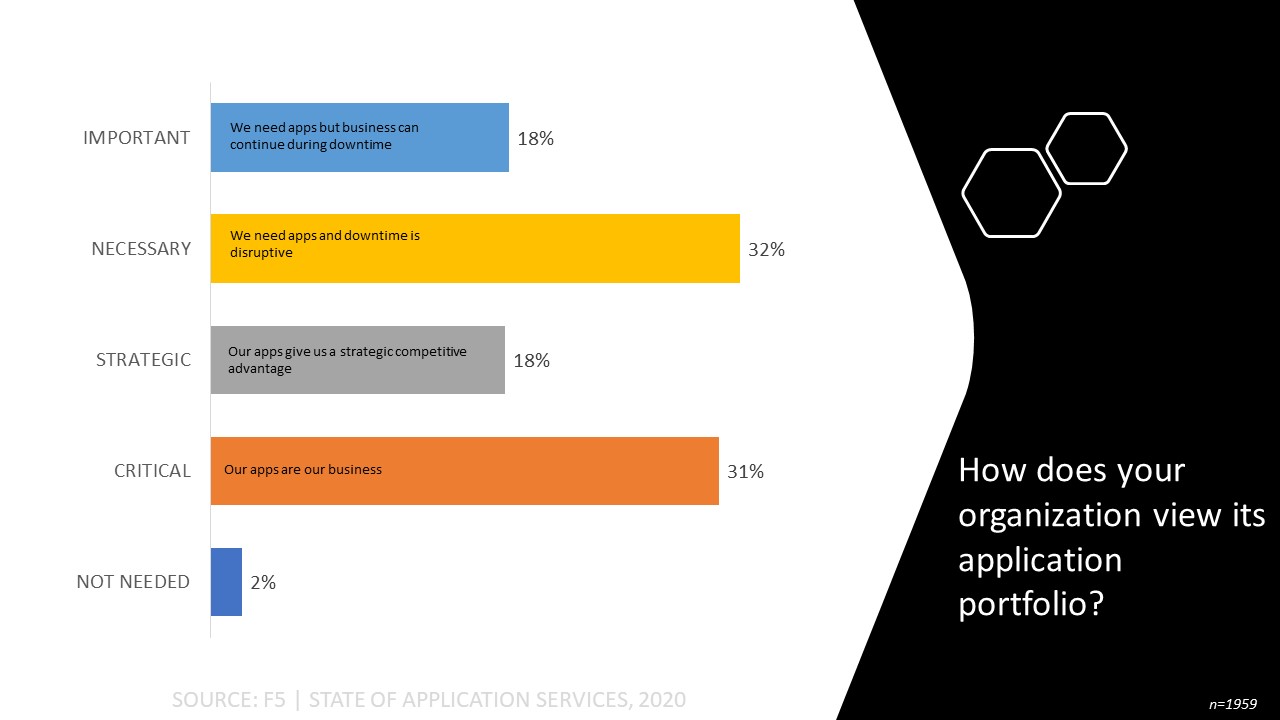Stand der Anwendungsdienste 2020: App-Einstellungen
Wenn wir uns jedes Jahr mit dem Stand der Anwendungsdienste befassen, konzentrieren wir uns nicht nur auf App-Dienste. Obwohl dies sicherlich unser Hauptinteresse ist, gibt es eine Vielzahl von Trends und Technologien, die sich allgemein auf App-Dienste auswirken.
Im Laufe der Jahre haben wir beobachtet, wie neue App-Architekturen, Automatisierung und Cloud einen zunehmenden Einfluss auf Anwendungsdienste hatten. Dies machte eine Umstellung von der Bereitstellung von App-Diensten als Software auf an Hardware gekoppelte Software, von virtuellen Maschinen zur Cloud und seit Kurzem auch zu Containern erforderlich.
Unsere Forschung zeigt, dass Organisationen heute unglaublich heterogen sind. Nicht nur bei der Einführung einer Multi-Cloud-Strategie, sondern auch bei ihrem Anwendungsportfolio .
Die Anwendungsdienste, die heutige Unternehmen unterstützen, müssen so vielfältig sein wie die Architekturen, aus denen sich ihre App-Portfolios zusammensetzen. Die Bedeutung dieser Vielfalt erkennen wir an der Vielzahl von Formfaktoren, die sich die Befragten für ihre Anwendungsdienste wünschen.
Im Jahr 2020 teilen uns die Befragten mit, dass sie sich containerisierte App-Dienste wünschen. Diese Nachfrage hat sich in nur zwei Jahren mehr als verdoppelt und ist von 9 % im Jahr 2018 auf 19 % im Jahr 2020 gestiegen. Gleichzeitig ist die Nachfrage nach virtuellen Maschinen von 30 % im Jahr 2018 auf nur noch 16 % im Jahr 2020 zurückgegangen. Es ist klar, dass Container auf Kosten virtueller Maschinen an Bedeutung gewinnen.
Dies sind jedoch nicht die einzigen Möglichkeiten, mit denen Unternehmen App-Dienste bereitgestellt haben möchten. Netzwerkgeräte (Hardware) bleiben mit 16 % der Befragten ebenso beliebt wie virtuelle Maschinen. Ganze 10 % bevorzugen die Bereitstellung von App-Diensten „als Service“. Weitere 6 % wünschen sich ein Web- oder App-Server-Plug-in wie etwa NGINX. Und 5 % sind an einer Anwendungsbibliothek als Bereitstellungsmedium interessiert. Diese Option deutet darauf hin, dass sowohl Entwickler als auch DevOps zunehmend an Anwendungsdiensten interessiert sind, da dieser Formfaktor eine enge Kopplung an die Anwendung selbst erfordert.
Wenn das seltsam klingt, sollte es das nicht. Gute 36 % aller Anwendungen werden heute intern entwickelt. Die Einbindung von App-Diensten als Teil der App ist in der Microservices-/Container-native-Landschaft ein zunehmend wichtiges Thema. Eine containernative Architektur umfasst einen bestimmten Satz von App-Diensten, ohne die die App nicht skaliert werden kann. Die Bereitstellungsraten für Ingress Control und Service Discovery – sowohl vor Ort als auch in der öffentlichen Cloud – steigen schnell an – parallel zur Zunahme von auf Microservices basierenden Apps im Unternehmensportfolio.
Dieses Portfolio wird zunehmend wichtiger und ist für diejenigen, die ihre digitale Transformation mit Hochdruck vorantreiben, von strategischer Bedeutung. Wir fragten die Teilnehmer, wie ihr Unternehmen sein App-Portfolio sieht, und waren wenig überrascht, als wir feststellten, dass die meisten Unternehmen auf Apps angewiesen sind und dass Ausfallzeiten störend sind.
Ebenso wenig überraschend ist der Zusammenhang zwischen Apps und digitaler Transformation. Während Unternehmen sich der letzten Phase ihrer Reise nähern, beginnen immer mehr von ihnen, ihre Apps als strategischen Wettbewerbsvorteil zu betrachten.
Die Sicht auf Anwendungen verändert sich seit Jahrzehnten, aber die digitale Transformation hat diesen Wandel beschleunigt. Heutzutage ist ein größerer Teil des Geschäftslebens untrennbar mit Anwendungen verknüpft als in der Vergangenheit. Und dieser Trend wird sich fortsetzen, da Unternehmen weiterhin neue Wege finden, über Anwendungen zusammenzuarbeiten und mit Partnern, Kunden und Mitarbeitern zu interagieren.
Wenn Sie Ihr Exemplar des diesjährigen Berichts noch nicht haben, können Sie es hier herunterladen .

